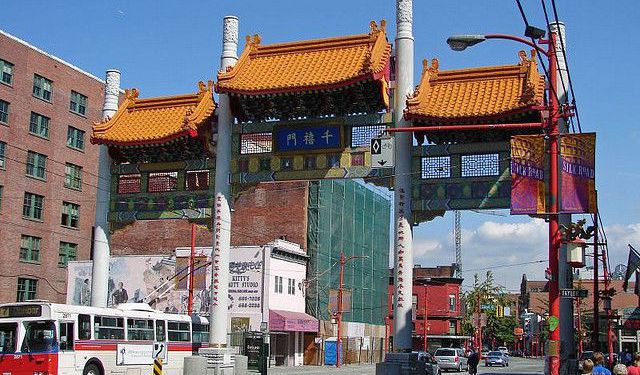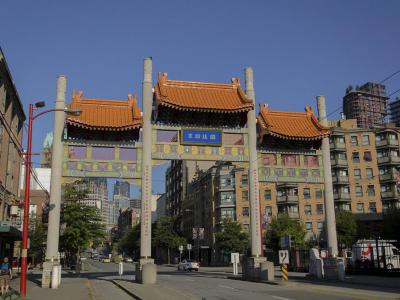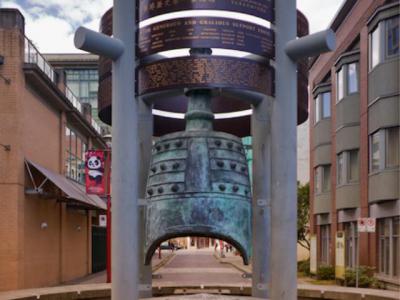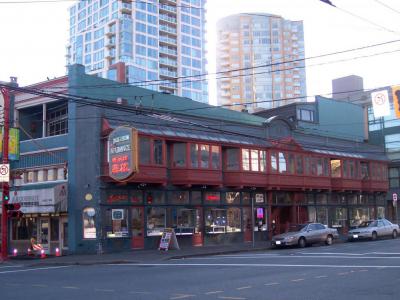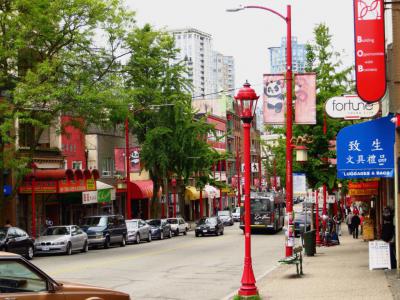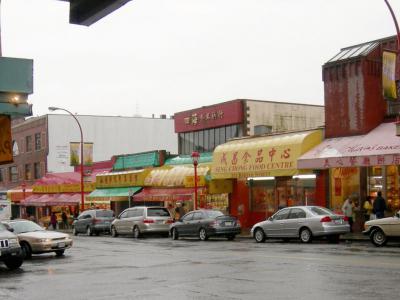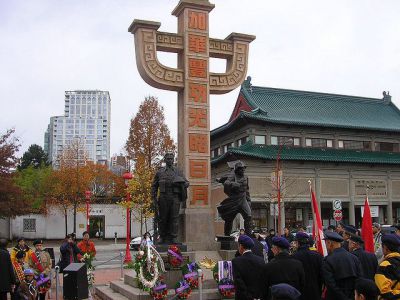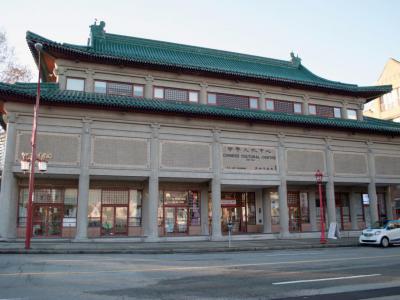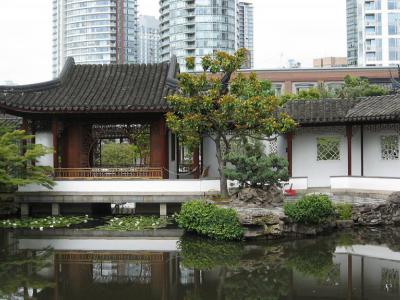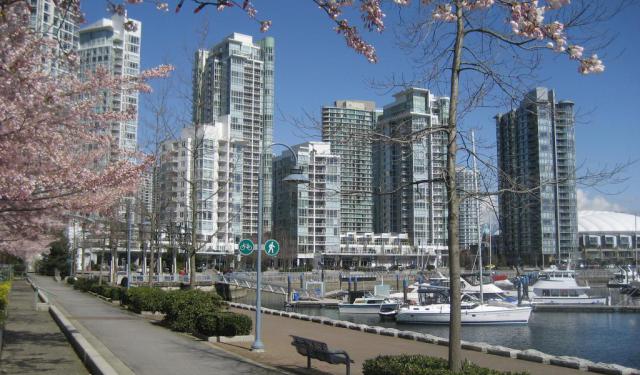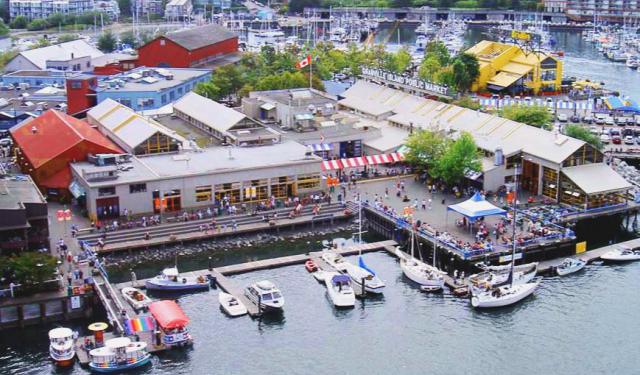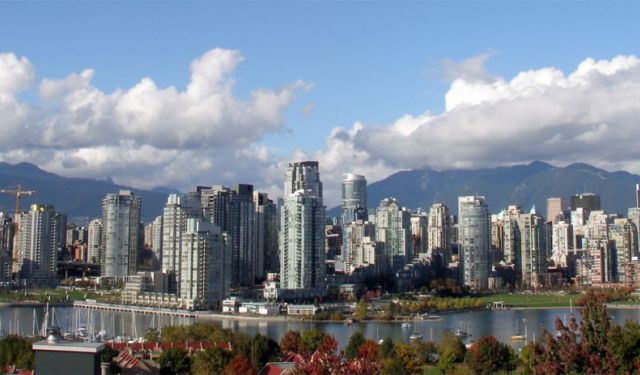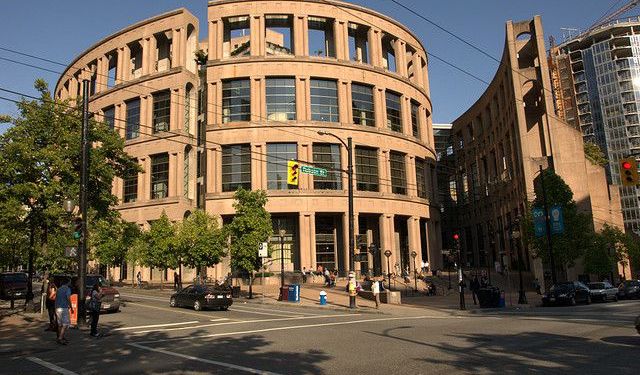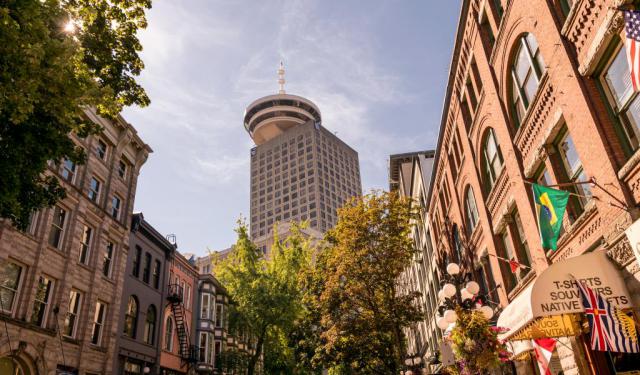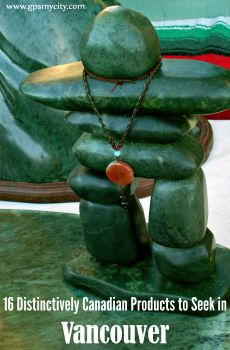Vancouver Chinatown Walking Tour (Self Guided), Vancouver
Vancouver's Chinatown is the second-largest Chinese-centered area in North America. As such, it has long attracted hordes of tourists with its expressive culture, inexpensive but delicious food, and fabulous traditional architecture.
The very first landmark that welcomes visitors entering Chinatown is the grand, ornate structure called the Millennium Gate. With its intricate architectural details and symbolic significance, this iconic gate represents the cultural connection between Vancouver and the Chinese community, serving as a symbol of unity.
Passing through the gate, to your right, find the historic Shanghai Alley, a narrow lane that holds a special place in the neighborhood's history. Once a center of activity for the Chinese community, today it retains its historical charm with traditional shops and businesses.
Standing further ahead is the Sam Kee Building, renowned for its incredibly narrow width, earning it a place in the Guinness World Records as the narrowest commercial building in the world – a true testament to the creative use of space in a busy urban environment!
East Pender Street and Keefer Street are the main arteries of Chinatown, lined with a variety of restaurants, shops, and cultural attractions. These streets come alive in the evenings, offering a vibrant food and nightlife scene with a wide range of gastronomic pleasures to savor.
The Monument of Canadian Chinese pays tribute to the contributions of the Chinese community to Canada's history and development. It's a significant reminder of the enduring impact of this community on the country.
The Chinese Cultural Center and Museum is a hub for preserving and promoting Chinese culture in Vancouver. Visitors can explore exhibits and events that showcase the rich heritage and traditions of the Chinese denizens.
For a tranquil escape, the Doctor Sun Yat-Sen Garden offers a peaceful oasis within the bustling city. This classical Chinese garden features typical architecture, serene ponds, and manicured greenery - a perfect place for reflection and relaxation.
Visiting Vancouver's Chinatown is a journey through history, culture, and culinary delights. If you wish to experience it all firsthand, take this self-guided tour of Vancouver's Chinatown and immerse yourself in the sights, flavors, and stories that await you in this captivating corner of the city.
The very first landmark that welcomes visitors entering Chinatown is the grand, ornate structure called the Millennium Gate. With its intricate architectural details and symbolic significance, this iconic gate represents the cultural connection between Vancouver and the Chinese community, serving as a symbol of unity.
Passing through the gate, to your right, find the historic Shanghai Alley, a narrow lane that holds a special place in the neighborhood's history. Once a center of activity for the Chinese community, today it retains its historical charm with traditional shops and businesses.
Standing further ahead is the Sam Kee Building, renowned for its incredibly narrow width, earning it a place in the Guinness World Records as the narrowest commercial building in the world – a true testament to the creative use of space in a busy urban environment!
East Pender Street and Keefer Street are the main arteries of Chinatown, lined with a variety of restaurants, shops, and cultural attractions. These streets come alive in the evenings, offering a vibrant food and nightlife scene with a wide range of gastronomic pleasures to savor.
The Monument of Canadian Chinese pays tribute to the contributions of the Chinese community to Canada's history and development. It's a significant reminder of the enduring impact of this community on the country.
The Chinese Cultural Center and Museum is a hub for preserving and promoting Chinese culture in Vancouver. Visitors can explore exhibits and events that showcase the rich heritage and traditions of the Chinese denizens.
For a tranquil escape, the Doctor Sun Yat-Sen Garden offers a peaceful oasis within the bustling city. This classical Chinese garden features typical architecture, serene ponds, and manicured greenery - a perfect place for reflection and relaxation.
Visiting Vancouver's Chinatown is a journey through history, culture, and culinary delights. If you wish to experience it all firsthand, take this self-guided tour of Vancouver's Chinatown and immerse yourself in the sights, flavors, and stories that await you in this captivating corner of the city.
How it works: Download the app "GPSmyCity: Walks in 1K+ Cities" from Apple App Store or Google Play Store to your mobile phone or tablet. The app turns your mobile device into a personal tour guide and its built-in GPS navigation functions guide you from one tour stop to next. The app works offline, so no data plan is needed when traveling abroad.
Vancouver Chinatown Walking Tour Map
Guide Name: Vancouver Chinatown Walking Tour
Guide Location: Canada » Vancouver (See other walking tours in Vancouver)
Guide Type: Self-guided Walking Tour (Sightseeing)
# of Attractions: 8
Tour Duration: 1 Hour(s)
Travel Distance: 1.3 Km or 0.8 Miles
Author: DanaOffice
Sight(s) Featured in This Guide:
Guide Location: Canada » Vancouver (See other walking tours in Vancouver)
Guide Type: Self-guided Walking Tour (Sightseeing)
# of Attractions: 8
Tour Duration: 1 Hour(s)
Travel Distance: 1.3 Km or 0.8 Miles
Author: DanaOffice
Sight(s) Featured in This Guide:
- Millennium Gate
- Historic Shanghai Alley
- Sam Kee Building
- East Pender Street
- Keefer Street Food and Nightlife
- Monument of Canadian Chinese
- Chinese Cultural Center and Museum
- Dr. Sun Yat-Sen Garden
1) Millennium Gate
Straddling West Pender Street near the intersection with Taylor Street is an awe-inspiring feat of architecture called the Millennium Gate. This four-pillar-, three-story-tall structure marks the entrance to Vancouver's famed Chinatown and was built in 2002 to celebrate the arrival of the new millennium.
But most importantly, it honours the role of Chinese settlers in the long and eventful history of the city. This includes both the early migrants from China, in the late 19th century, and those ethnic Chinese who came from Latin America later on.
The piece was designed to commentate a journey in time as well as to represent both the past and the future. With tall poles appearing to precariously hold up the orange roof, three large rectangular gray slabs, and ornate carvings on the top edges, the Millennium Gate makes an interesting sight in which new art forms occur within a very traditional setting.
The two stone foo lions, guarding the gate, include one male – on the left – with a ball under his paw, and one female – on the right – holding a cub. The images of people depicted in the upper portion of the gate show different styles of clothing typical for various parts of China. Another interesting feature is the colour scheme, a blend of traditional Eastern and modern Western-inspired motifs.
Many plaques and dedications to those involved in the project adorn the lower portion of the gate.
Vancouver's Chinatown is a living symbol of multiculturalism. It serves as a place where people of every ethnicity gather to partake in the sampling of delicacies from the local restaurants and shops and to interact with the locals that are an integral part of Vancouver society.
But most importantly, it honours the role of Chinese settlers in the long and eventful history of the city. This includes both the early migrants from China, in the late 19th century, and those ethnic Chinese who came from Latin America later on.
The piece was designed to commentate a journey in time as well as to represent both the past and the future. With tall poles appearing to precariously hold up the orange roof, three large rectangular gray slabs, and ornate carvings on the top edges, the Millennium Gate makes an interesting sight in which new art forms occur within a very traditional setting.
The two stone foo lions, guarding the gate, include one male – on the left – with a ball under his paw, and one female – on the right – holding a cub. The images of people depicted in the upper portion of the gate show different styles of clothing typical for various parts of China. Another interesting feature is the colour scheme, a blend of traditional Eastern and modern Western-inspired motifs.
Many plaques and dedications to those involved in the project adorn the lower portion of the gate.
Vancouver's Chinatown is a living symbol of multiculturalism. It serves as a place where people of every ethnicity gather to partake in the sampling of delicacies from the local restaurants and shops and to interact with the locals that are an integral part of Vancouver society.
2) Historic Shanghai Alley
Historic Alley marks the area of Vancouver's earliest Chinese settlement. Originally comprising Canton and Shanghai alley, this neighborhood housed more than 1,000 Asian-Canadian residents, and was home to stores, restaurants, opera and other cultural activities.
Shanghai Alley was the first part of Historic Alley to be constructed and inhabited. Later, in 1904, Canton Alley was added. Eventually, this was followed by a Chinese-style courtyard surrounded with residential and commercial buildings running in two parallel, southward rows. The heart of Historic Alley was the 500-seat theater, built in 1898, surrounded by restaurants and shops. This gave residents of Chinatown a way to enjoy Chinese-language entertainment, food, and company without having to leave their Vancouver home district, and ultimately resulted in a tightly woven Chinese-Canadian community, within the boundaries of which one could spend their entire life.
The end result of Historical Alley is a Chinatown that is the second largest in all of North America, and one of the most visited by ethnic Chinese from outside of Vancouver. People of all races and nationalities come to Historical Alley for food, shopping, entertainment, and cultural events, as well as to view the Millennium Gate which crowns the Chinatown entrance.
Another key sight to behold here, set in the centre of Shanghai Alley, is the Western Han Dynasty Bell. This bell is a replica of the one unearthed in 1983 during an excavation in Guangzhou, China, and was gifted to the people of Vancouver from the city of Guangzhou on the occasion of the 15th anniversary of the two cities twinning. While the original bell dates back over two millennia and symbolizes the age of settlement in the Pearl River delta in Guangzhou, its replica marks the spot of the first Chinese settlement in the lower mainland of British Columbia.
Shanghai Alley was the first part of Historic Alley to be constructed and inhabited. Later, in 1904, Canton Alley was added. Eventually, this was followed by a Chinese-style courtyard surrounded with residential and commercial buildings running in two parallel, southward rows. The heart of Historic Alley was the 500-seat theater, built in 1898, surrounded by restaurants and shops. This gave residents of Chinatown a way to enjoy Chinese-language entertainment, food, and company without having to leave their Vancouver home district, and ultimately resulted in a tightly woven Chinese-Canadian community, within the boundaries of which one could spend their entire life.
The end result of Historical Alley is a Chinatown that is the second largest in all of North America, and one of the most visited by ethnic Chinese from outside of Vancouver. People of all races and nationalities come to Historical Alley for food, shopping, entertainment, and cultural events, as well as to view the Millennium Gate which crowns the Chinatown entrance.
Another key sight to behold here, set in the centre of Shanghai Alley, is the Western Han Dynasty Bell. This bell is a replica of the one unearthed in 1983 during an excavation in Guangzhou, China, and was gifted to the people of Vancouver from the city of Guangzhou on the occasion of the 15th anniversary of the two cities twinning. While the original bell dates back over two millennia and symbolizes the age of settlement in the Pearl River delta in Guangzhou, its replica marks the spot of the first Chinese settlement in the lower mainland of British Columbia.
3) Sam Kee Building
Situated on West Pender Street in Vancouver, the Sam Kee Building claims the title of the "most slender commercial edifice globally," an accolade officially recognized by the Guinness Book of Records.
Originally belonging to the Sam Kee Company, overseen by Chang Toy, a prominent figure in Vancouver Chinatown and renowned businessman, the property was procured in 1903 on a standard-sized plot. However, a turning point occurred in 1912 when the city of Vancouver decided to widen Pender Street, leading to the expropriation of a considerable 24 feet (7.3 meters) of the property's above-ground area. This alteration seemingly rendered traditional commercial utilization of the remaining frontage unfeasible, if not entirely unattainable.
When offered to sell the land next door, Toy refused, unsure of its purpose. In 1913, architects Brown and Gillam were hired to design a unique narrow steel-framed building. The first floor is 4.9 feet (1.50 meters) deep, the second floor extends 6 feet (1.83 meters) from a bay window, and the basement had public baths. The ground floor had shops/offices, and the upper level was residential.
Soren Rasmussen spearheaded the historical restoration of the building, culminating in its completion in 1986. Presently, the structure serves as a tourist attraction and houses an insurance office.
Famous as the world's narrowest commercial building, the Sam Kee Building was once recognized by Ripley's Believe It or Not! But, the title was questioned when Pittsburgh's "Skinny Building" emerged, challenging Sam Kee's record. The debate centers on Sam Kee's varying floor widths, occasionally 6 feet wide, while Pittsburgh's building maintains a consistent 5.2 feet (1.57 meters) width on all floors.
Originally belonging to the Sam Kee Company, overseen by Chang Toy, a prominent figure in Vancouver Chinatown and renowned businessman, the property was procured in 1903 on a standard-sized plot. However, a turning point occurred in 1912 when the city of Vancouver decided to widen Pender Street, leading to the expropriation of a considerable 24 feet (7.3 meters) of the property's above-ground area. This alteration seemingly rendered traditional commercial utilization of the remaining frontage unfeasible, if not entirely unattainable.
When offered to sell the land next door, Toy refused, unsure of its purpose. In 1913, architects Brown and Gillam were hired to design a unique narrow steel-framed building. The first floor is 4.9 feet (1.50 meters) deep, the second floor extends 6 feet (1.83 meters) from a bay window, and the basement had public baths. The ground floor had shops/offices, and the upper level was residential.
Soren Rasmussen spearheaded the historical restoration of the building, culminating in its completion in 1986. Presently, the structure serves as a tourist attraction and houses an insurance office.
Famous as the world's narrowest commercial building, the Sam Kee Building was once recognized by Ripley's Believe It or Not! But, the title was questioned when Pittsburgh's "Skinny Building" emerged, challenging Sam Kee's record. The debate centers on Sam Kee's varying floor widths, occasionally 6 feet wide, while Pittsburgh's building maintains a consistent 5.2 feet (1.57 meters) width on all floors.
4) East Pender Street
Vancouver’s Chinatown is an exciting place where the old and modern come together. The areas of East Pender Street and the rectangle formed by Pender, Main, Keefer, and Gore streets are a true paradise for shoppers keen on all things Asian. Here, alongside locals perpetually searching for specialty ingredients for dinner, you will find the young and hip crowd checking out independent stores. The variety of things on offer is enormous, spanning from ginseng to green teas, fine embroidered linen, silk robes, exotic fresh produce, plus traditional Chinese tableware and cooking utensils.
The area is also noted for the abundance of natural pharmacies and herbalists, as well as numerous restaurants and smaller eateries serving freshly-made Asian delicacies: from moon cake to roasted duck. When it comes to steam buns, the best place to get them in Chinatown is New Town Bakery. The joint serves a variety of 13 different steam buns, ranging from $1.65 to $3.30 apiece, filled with pork, chicken, beef, sweet custard, sweet lotus paste, and egg yolk.
Speaking of modern, a number of cool new stores lining East Pender Street, west of Main, really break the Chinatown mold, offering skateboard decks, vintage clothing, cocktail sets, and club wear. A special mention deserves the something-for-everyone Bamboo Village, at 135 East Pender Street. The shop is specialized in all things bamboo – from furniture, paper lanterns, and worship supplies to Maoist memorabilia, Chinese folk art, and home decor.
The emerging neighbourhood between Main Street and Carrall Street is also home to many notable businesses, such as Kissa Tanto, Umaluma, Propaganda Coffee, Bao Bei, Aubade Coffee, and others. Paired with a bunch of mixed-use development projects completed in recent years, this creates one of the fastest-growing and most dynamic neighborhoods in Vancouver.
The area is also noted for the abundance of natural pharmacies and herbalists, as well as numerous restaurants and smaller eateries serving freshly-made Asian delicacies: from moon cake to roasted duck. When it comes to steam buns, the best place to get them in Chinatown is New Town Bakery. The joint serves a variety of 13 different steam buns, ranging from $1.65 to $3.30 apiece, filled with pork, chicken, beef, sweet custard, sweet lotus paste, and egg yolk.
Speaking of modern, a number of cool new stores lining East Pender Street, west of Main, really break the Chinatown mold, offering skateboard decks, vintage clothing, cocktail sets, and club wear. A special mention deserves the something-for-everyone Bamboo Village, at 135 East Pender Street. The shop is specialized in all things bamboo – from furniture, paper lanterns, and worship supplies to Maoist memorabilia, Chinese folk art, and home decor.
The emerging neighbourhood between Main Street and Carrall Street is also home to many notable businesses, such as Kissa Tanto, Umaluma, Propaganda Coffee, Bao Bei, Aubade Coffee, and others. Paired with a bunch of mixed-use development projects completed in recent years, this creates one of the fastest-growing and most dynamic neighborhoods in Vancouver.
5) Keefer Street Food and Nightlife
In 2010, Condé Nast Traveler described Vancouver's Chinese food as "the best in the world," better even than in Hong Kong or mainland China! Despite the abundance of incredible Chinese food available on East Pender Street, Keefer Street is just as prominent foodie's destination in Vancouver Chinatown, with a few stand-outs of its own.
Among them are Gold Stone Bakery & Restaurant (139 Keefer Street), a local favorite renowned for its Hong Kong-style diner food and sweets, including egg tarts and sticky buns; Kent's Kitchen (232 Keefer Street) – serving big portions of Chinese fare with a small price tag; Floata Seafood Restaurant (180 Keefer Street), a classic Chinese restaurant that hosts Chinese New Year celebrations and is most famous for its seafood and dim sum; and Bao Bei (163 Keefer Street) noted for its contemporary twist on Chinese cuisine in a trendy eclectic space. Its seasonal menu harmoniously blends Chinese and French culinary traditions, reinforced with an interesting cocktail list to match. Great date spot, and you can’t go wrong with the menu.
Another point of interest is Gain Wah Restaurant, at 218 Keefer Street, offering a taste of old school Chinatown. This place may not look like much on the outside, but on the inside it will win you over hands down with its cheap, but finger-licking quality Chinese tucker. And if that's not enough, there are also several terrific Chinese markets on Keefer Street worth checking out, just before Gore Avenue, including San Lee Enterprises (267 Keefer Street), a perfect place to shop for seasonal fruits, or Sing Chong Food Centre (253 Keefer Street), a must-stop for all types of BBQ meats.
Keefer Street is also home to Vancouver's major nightspot – Keefer Bar at number 135 – which has put Chinatown firmly on the map of nightlife entertainment alongside prominent destinations, like Gastown and the Granville Street Entertainment District. This is one of the city's Top 10 Cocktail Bars with a strong reputation for fabulous original cocktails containing Chinatown-sourced ingredients. Come have a sip, whenever you get a chance!
Among them are Gold Stone Bakery & Restaurant (139 Keefer Street), a local favorite renowned for its Hong Kong-style diner food and sweets, including egg tarts and sticky buns; Kent's Kitchen (232 Keefer Street) – serving big portions of Chinese fare with a small price tag; Floata Seafood Restaurant (180 Keefer Street), a classic Chinese restaurant that hosts Chinese New Year celebrations and is most famous for its seafood and dim sum; and Bao Bei (163 Keefer Street) noted for its contemporary twist on Chinese cuisine in a trendy eclectic space. Its seasonal menu harmoniously blends Chinese and French culinary traditions, reinforced with an interesting cocktail list to match. Great date spot, and you can’t go wrong with the menu.
Another point of interest is Gain Wah Restaurant, at 218 Keefer Street, offering a taste of old school Chinatown. This place may not look like much on the outside, but on the inside it will win you over hands down with its cheap, but finger-licking quality Chinese tucker. And if that's not enough, there are also several terrific Chinese markets on Keefer Street worth checking out, just before Gore Avenue, including San Lee Enterprises (267 Keefer Street), a perfect place to shop for seasonal fruits, or Sing Chong Food Centre (253 Keefer Street), a must-stop for all types of BBQ meats.
Keefer Street is also home to Vancouver's major nightspot – Keefer Bar at number 135 – which has put Chinatown firmly on the map of nightlife entertainment alongside prominent destinations, like Gastown and the Granville Street Entertainment District. This is one of the city's Top 10 Cocktail Bars with a strong reputation for fabulous original cocktails containing Chinatown-sourced ingredients. Come have a sip, whenever you get a chance!
6) Monument of Canadian Chinese
The Monument of Canadian Chinese is a memorial commemorating the Chinese people's contribution to Canada's history, and is located on the edge of Vancouver's Chinatown area.
The monument is constructed of light coloured rock, flanked by two bronze statues. One of the statues is a railway worker, set to commemorate the many thousands of Chinese who worked to help lay track for the transcontinental railroad, and some of whom lost their lives while performing this back breaking labour. The other statue is a World War II soldier, honouring the Chinese-Canadians who enlisted to fight in the war. Their bravery eventually earned them the right to vote in 1945, and furthered their acceptance in the mainstream Vancouver society. This monument also serves as a focal point for the Remembrance Day ceremonies in Chinatown.
Furthermore, it serves as a reminder of Vancouver's multiculturalism, much as a testament to the hundreds of Canadian residents of Chinese descent who have paid the ultimate price helping to make Canada great. Vancouver would not be the city it is today without the sacrifices of thousands of Chinese people, and the Monument of Canadian Chinese is Vancouver's way of acknowledging their place in the country's history.
The monument is constructed of light coloured rock, flanked by two bronze statues. One of the statues is a railway worker, set to commemorate the many thousands of Chinese who worked to help lay track for the transcontinental railroad, and some of whom lost their lives while performing this back breaking labour. The other statue is a World War II soldier, honouring the Chinese-Canadians who enlisted to fight in the war. Their bravery eventually earned them the right to vote in 1945, and furthered their acceptance in the mainstream Vancouver society. This monument also serves as a focal point for the Remembrance Day ceremonies in Chinatown.
Furthermore, it serves as a reminder of Vancouver's multiculturalism, much as a testament to the hundreds of Canadian residents of Chinese descent who have paid the ultimate price helping to make Canada great. Vancouver would not be the city it is today without the sacrifices of thousands of Chinese people, and the Monument of Canadian Chinese is Vancouver's way of acknowledging their place in the country's history.
7) Chinese Cultural Center and Museum
Despite the contributions of Chinese-Canadians to Canada's history, cities like Vancouver were plagued by anti Chinese sentiment for years. It took until 1945 for Chinese-Canadians to be granted the right to vote, despite the fact that many of them slaved to build Canada's transcontinental railroad, and enlisted in World War II. The Chinese Cultural Center and Museum honours their sacrifices, and serves as a means of preserving the historical contributions of Chinese-Canadians. The Museum is home to artifacts and archives dating back to the Gold Rush, when anti Chinese sentiment was at its highest, and many Chinese people sacrificed their lives to make Canada great.
The Chinese Cultural Center and Museum is located in Vancouver's Chinatown, the second largest Chinatown in all of North America. Visitors can call ahead to book a tour of the Museum itself, and can contact the center to ask about workshops, classes, and other programs. The Cultural Center gives visitors the opportunity to learn about traditional Chinese calligraphy, tai chi, and more.
The Chinese Museum and Cultural Center is located near Dr. Sun Yat-Sen Garden. If you are planning a tour of Vancouver's Chinatown area, no visit can be complete without a stop at the Museum to learn about Chinese-Canadian history, and the Garden for a relaxing walk.
The Chinese Cultural Center and Museum is located in Vancouver's Chinatown, the second largest Chinatown in all of North America. Visitors can call ahead to book a tour of the Museum itself, and can contact the center to ask about workshops, classes, and other programs. The Cultural Center gives visitors the opportunity to learn about traditional Chinese calligraphy, tai chi, and more.
The Chinese Museum and Cultural Center is located near Dr. Sun Yat-Sen Garden. If you are planning a tour of Vancouver's Chinatown area, no visit can be complete without a stop at the Museum to learn about Chinese-Canadian history, and the Garden for a relaxing walk.
8) Dr. Sun Yat-Sen Garden
The Dr. Sun Yat-Sen Garden situated in Vancouver stands as the inaugural Chinese or "scholars" garden constructed beyond China's borders. Its inception took place from 1985 to 1986, timed to coincide with Expo 86. Funding for the project materialized through a collaboration between the Chinese and Canadian governments, along with contributions from Vancouver's Chinese community, as well as various public and private benefactors.
The garden receives its name as a tribute to Dr. Sun Yat-Sen, acclaimed as the pioneering president of the Republic of China and revered as the "father" of the contemporary Chinese nation. In his pursuit of advancing the Chinese nationalist movement during the early 20th century, Sun Yat-Sen found himself in Vancouver on three separate occasions for extended stays.
This venue seamlessly incorporates a public park and a traditional Chinese garden, distinct yet interconnected by way of an artificial pond. The exterior park design was masterminded by local architects, while the inner garden's conception was guided by experts hailing from Suzhou, China.
The classical garden embodies Taoist and Feng Shui ideals for balance through opposites. The public park combines Western and Chinese styles, using local North American materials. Park entry is free, while the garden charges for admission, providing guided tours for an enriched visit.
Due to the similar winter climates of Vancouver and Suzhou, many plants in the garden look much like those in Suzhou. Carefully chosen to highlight seasonal changes, especially the spring rejuvenation, these plants are deliberately arranged with restraint. Unlike exuberant Western gardens, this design adds color to the landscape throughout the year.
Tip:
If you're unsure about the fee, you can always try the free public park first, as it also has a little pond, bridges, and beautiful views.
The garden receives its name as a tribute to Dr. Sun Yat-Sen, acclaimed as the pioneering president of the Republic of China and revered as the "father" of the contemporary Chinese nation. In his pursuit of advancing the Chinese nationalist movement during the early 20th century, Sun Yat-Sen found himself in Vancouver on three separate occasions for extended stays.
This venue seamlessly incorporates a public park and a traditional Chinese garden, distinct yet interconnected by way of an artificial pond. The exterior park design was masterminded by local architects, while the inner garden's conception was guided by experts hailing from Suzhou, China.
The classical garden embodies Taoist and Feng Shui ideals for balance through opposites. The public park combines Western and Chinese styles, using local North American materials. Park entry is free, while the garden charges for admission, providing guided tours for an enriched visit.
Due to the similar winter climates of Vancouver and Suzhou, many plants in the garden look much like those in Suzhou. Carefully chosen to highlight seasonal changes, especially the spring rejuvenation, these plants are deliberately arranged with restraint. Unlike exuberant Western gardens, this design adds color to the landscape throughout the year.
Tip:
If you're unsure about the fee, you can always try the free public park first, as it also has a little pond, bridges, and beautiful views.
Walking Tours in Vancouver, Canada
Create Your Own Walk in Vancouver
Creating your own self-guided walk in Vancouver is easy and fun. Choose the city attractions that you want to see and a walk route map will be created just for you. You can even set your hotel as the start point of the walk.
Vancouver Yaletown Walking Tour
For many years, Yaletown was the thriving industrial heart of Vancouver. Today, this historic neighborhood looks unlike any other part of the city and is considered to be the home of Vancouver's "elite" society.
The Roundhouse Community Arts & Recreation Centre is a prominent landmark here, serving as a hub for art exhibitions and recreational activities. Its historic... view more
Tour Duration: 1 Hour(s)
Travel Distance: 1.7 Km or 1.1 Miles
The Roundhouse Community Arts & Recreation Centre is a prominent landmark here, serving as a hub for art exhibitions and recreational activities. Its historic... view more
Tour Duration: 1 Hour(s)
Travel Distance: 1.7 Km or 1.1 Miles
Granville Island Walking Tour
Successfully transformed, back in the 1970s, from an industrial wasteland into one of the most beloved public spaces in Vancouver, Granville Island is now viewed as a premier artistic and cultural hub famous for its balance of functionality and flare. It is equally popular as a shopping destination, too, with a plethora of other attractions like art galleries, markets, and a brewery to boot.... view more
Tour Duration: 1 Hour(s)
Travel Distance: 1.1 Km or 0.7 Miles
Tour Duration: 1 Hour(s)
Travel Distance: 1.1 Km or 0.7 Miles
Vancouver Introduction Walking Tour
A bustling seaport on the west coast of Canada, Vancouver is among the country's densest and most ethnically diverse cities. It is also one of British Columbia's youngest cities. Prior to the Europeans, the Vancouver area had been inhabited – for almost 10,000 years – by Aboriginal tribes: Squamish, Musqueam, and Tsleil-Waututh (Burrard). The explorer Simon Fraser and his crew were... view more
Tour Duration: 2 Hour(s)
Travel Distance: 3.7 Km or 2.3 Miles
Tour Duration: 2 Hour(s)
Travel Distance: 3.7 Km or 2.3 Miles
Vancouver Downtown Walking Tour
Numerous historic and otherwise notable landmarks scattered throughout Downtown Vancouver make it a hot traveler's destination. Each such landmark is unique in itself and has a great deal of story to tell visitors, be it cultural history or simple amusement.
While in Downtown you can't miss the Vancouver Lookout. This observation deck lures you with its breathtaking scenery – the... view more
Tour Duration: 2 Hour(s)
Travel Distance: 3.7 Km or 2.3 Miles
While in Downtown you can't miss the Vancouver Lookout. This observation deck lures you with its breathtaking scenery – the... view more
Tour Duration: 2 Hour(s)
Travel Distance: 3.7 Km or 2.3 Miles
Gastown Walking Tour
To get the feel of authentic Vancouver, head for the Gastown district. This is where the city was born: an ex-sailor turned gold prospector built an inn here in the late 19th century and a small settlement, mostly of mill workers, dockhands and merchants, sprang up around it. Many of the streets in Gastown are still cobblestoned and you will find lovely examples of Victorian buildings that have... view more
Tour Duration: 1 Hour(s)
Travel Distance: 2.1 Km or 1.3 Miles
Tour Duration: 1 Hour(s)
Travel Distance: 2.1 Km or 1.3 Miles
Useful Travel Guides for Planning Your Trip
14 Distinctively Canadian Things to Buy in Vancouver
British Columbia, in general, and Vancouver, in particular, are among the top Canadian destinations worth being explored. The amalgam of aboriginal and western cultures, Vancouver is a treasure trove of distinctively Canadian delights that are not found anywhere else. Most of these items make for an...
The Most Popular Cities
/ view all
